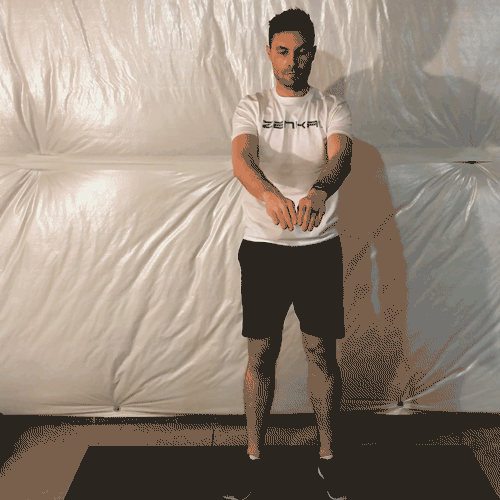Top Neck Pain Prevention and Treatments Tips
Neck Pain Prevention
Are you just tuning into this post now? If so, check out what you missed in part one of this article which included the leading causes of your neck pain and a delightful little anatomy overview.
Prevention of the initial pain and even ongoing chronic pain first start by having the proper ergonomic set up at your station. In previous posts, I break down the correct setup of your chair, desk, monitor keyboard and even mouse so check them out for a more in-depth explanation.
For this post, my goal is to give a snapshot of ways to improve your workstation. Let’s take a look:
Taking Breaks
Breaking up prolonged sitting or standing helps the tight muscles to relax and the stretched/strained muscles to rest. When sitting at your desk, I would recommend taking a 1-2 minute break every 30 minutes if possible. Taking a little walk around your office or doing something like Bruegger’s exercises (see below) will make a huge difference throughout your workday.
Desk Exercises
I’m not saying I want you to do max rep benches or handstand push-ups at your desk, but you need to be moving more while working at a desk all day. These stretches should be held for 10-20 seconds or until you feel like you’ve achieved an adequate stretch.
Simple Active Range of Motion
Forward flexion, extension, ear-to-shoulder, and rotation of the neck can make a world of difference. The exercises should feel like a light stretching sensation. Anything more than a stretching sensation (i.e., burning feeling) is a sign you are pushing the tissues too far.
Chest openers
This simple exercise helps stretch your pectoral muscles, which are contracted/overactive all day while typing. Stand up, put your arms out in front of you, bring them to your sides, now extend them back until you feel a stretch or until you feel……...your chest open. Makes sense right?
Scapular pinches
Since your chest is contracted all day, it would make sense that the opposing muscle groups are overstretched. Our goal is to always balance the opposing muscles group and therefore strengthen the rhomboids. Start by getting out of your chair, standing up with a neutral neck/spine, bring your shoulder blades together, and pretend to hold a pencil between them until fatigue.
Lower Trapezius activation
This muscle often gets overlooked when exercising and therefore is weak in most people. To activate your lower trap muscles first sit or stand straight up. Next try to pull your shoulder blade down without compromising your current position, adding a slight midline angle to the move.
Tailoring your posture
I’ve stated in previous posts that I like to think of posture in a cogwheel system. The picture below helps illustrate this point much better than my own words. I also would like to reiterate this point: Posture is not a 100% absolute thing, but rather a majority of the time thing. It’s nearly impossible to have perfect posture, however, if you can make a majority of the time thing you are on the right path.
Sticker Method
I’m a huge fan of this useful little trick. The premise is to have a sticker, piece of tape, or little reminder on the border of your monitor to give you a visual cue to check your posture. Everyone has at least one position while sitting that is terrible for them, i.e., sitting on your leg, leaning to one side, or crossing your feet under your desk (that’s mine).
With this little tip, it should help curb the amount of time you spend in your “bad habit” position. You may be wondering, “Why we are putting so much emphasis on the shoulder blade when my neck, back, and wrist are hurting so bad?”
Everything in the upper back/shoulder complex is connected, whether it is via nerve innervation, blood supply, sharing fascia (connective tissue similar to the silvery/white tissue on meat). Therefore, we need part working in unison to help every other part of the upper back. Also, read these two nuggets of info:
Scapular Functions
Aids in shoulder movement and rhythm by providing the socket in the ball-socket complex of the shoulderProvides the foundation for movement for the shoulder. Without a proper foundation, there is an increased strain on all muscles of the upper back
Treatment
Treatment first starts with prevention and the points I outlined above. Your next step is seeking treatment with a healthcare professional so they can give you guidance based on your specific needs. Here’s what and whom you should be seeking:
Tissue work
Transverse Friction Massage, Myofascial Release Technique, and Fascial Distortion Model are just a few of the techniques that work well for tissue relief. The primary goal of myofascial work is to release the adhesions within the muscles and tendons. The problematic area in the upper back is usually the trapezius muscles (in my years of chiropractic experience). They cover a majority of this region and are chronically tight in desk workers. If you have ever had a “knot” or spasm in your neck, tissue work is what you will first need to address.
Chiropractic Work
I’m obviously a little bias towards chiropractic, but I know it works for injuries I see in my practice day in and day out. I would seek out chiros that have an emphasis on soft tissue work and rehab based practice. Chiropractors are also able to manipulate the vertebrate, which helps put motion into the joints of the neck. When muscles spasm, they will in-turn lock down the joints of the neck and back. This sensation you have felt numerous times and knew it as have a stiff neck or a “crook” in your neck. Manipulation relieves this stiffness and puts much-needed motion into joints.
Rocktaping
I use this form of bracing and stability almost every day in my practice. Rocktaping adds stability but also allows the upper back and shoulder while allowing both to move freely. The muscles are also able to move more freely which prevents atrophy and further destabilization in the upper back.
Strengthening of the Region
The goal with strengthening here is not necessarily to add mass, but to build up endurance for the daily struggles of desk work. The three muscle groups I want to focus on are the deep neck flexors, serratus anterior, and the rhomboids. All of these are inhibited throughout the day as we type and sit. Our mission is to get these suckers back into fighting shape and get them back to doing their job of stabilization. With all of these strengthening exercises make sure you feel comfortable while doing them and are only doing daily reps of 10-20 reps.
Deep neck flexor activation
Begin by lying on your back on a flat surface and slowly lift your head off of the surface. Your goal here is to hover less than a quarter inch off the ground. We don’t want any crunching style flexion here at all. Hold that position for as long as you feel comfortable and rest your head. You should be feeling the fatigue sensation in the front of your neck but deeper than you are probably used too.
Rhomboid activation
Most of this is listed above so please refer to that.
Serratus anterior
Our wonderful stabilizing friend is here again, and although we addressed some exercises already we have just one more. This exercise is called a push plus or serratus push-up. While on all fours and with a neutral spine start to do a push-up. Rather than bending your arms you want to drop your sternum to the floor then push your sternum away from the floor. Hold that position to fatigue then go back to the neutral spine. You should feel the fatigue burning sensation on the underside of your shoulder blades.
Wrapping Up
Well, you made it to the end, so snaps and claps for you. It's a lot of info in one sitting I know, but if even one of the points above helps you, it’s worth it.
Neck/upper back pain will continue to grow in prevalence in our world with increased technology use.
My goal is to help break up the nasty habits you have formed over the years and add some stability to the area. Thank you for reading as always and please email/comment/direct message me any questions you might have.








